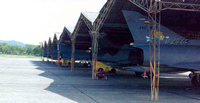Simulación y optimización en la logística
DOI:
https://doi.org/10.18667/cienciaypoderaereo.80Keywords:
simulación, cadenas de suministro, logística, optimización, investigación de operacionesAbstract
Nowadays, operations research is a useful tool in the process of design, execution and control of logistic systems; however, one of the most useful tools is simulation, which is an available technique for probtem solving. One of the first references to simulation goes back to the year 1940, when a scientist by the name of Ullman, appfied and designed the technique called "Montecarlo simulation". Simulation later began to grow through its application in NASA's aerospace design processes, among others, and at this moment simulation is used in diverse areas of the commercial, industrial, and military sectors, such as logistics, operation management, and lately in diverse military activities around the world, like the lraq war. This article presents a critical overview for those who are beginning to research simulation in logistical processes and are interested in using this tool to improve strategic, tactical, and operative level supply chains. lt defines simulation applied to logistics, its main applications, classifications and development methodology, in order to introduce the reader to this kind of optimization processes.
Downloads
References
April, J. y otros tres autores, New advances and applications for marrying simulation and optimization, Actas de 2004 Winter Simulation Conference, 1, 76-82, Washington DC, USA, 5 al 8 de Diciembre (2004).
Bandinelli, R. y otros tres autores, Using simulation for supply chain analysis: reviewing and proposing distributed simulation frameworks, Production Planning & Control, 17(2), 167-175 (2006)
https://doi.org/10.1080/09537280500224051
Ding, H. Y otros cuatro autores, "ONE" a new tool for Supply Chain Network optimization and simulation, Actas de 2004 Winter Simulation, 2, 343-350 Washington DC, USA, 5 al 8 de Diciembre (2004)
Sarjoughian, H.S. y otros seis autores, Hybrid Discrete Event Simularian with Model Predictive Control for Semiconductor Supply-Chain Manufacturing, Actas de 2005 Winter Simulation Conference 256-266, Orlando, USA, 4 al 7 Diciembre (2005)
Umeda, S. y F. Zhang, Supply Chain simularian: generic models and application examples, Production Planning & Control, 17 (2), 155-166 (2006)
https://doi.org/10.1080/09537280500224028
Villegas F.A Y N. R. Smithz, Supply chain dynamics: analysis of inventory vs. arder oscilations trade off; Int. J. of Production Research, 44 (6), 1037-1054 (2006)
https://doi.org/10.1080/00207540500338203
Zhang, C. y otros tres autores, Sharing shipment quantity infomation in the supply chain, Omega 34 (5) 427-438 (2006) Tambien en línea: http://www.scodus.com/scoDus/search/form.url. Acceso 12 de junio de junio (2006)

Downloads
Published
Issue
Section
License
Assignment of Copyrights
Authors assign Ciencia y Poder Aéreo journal the exclusive rights (reproduction, distribution, public communication, and transformation) to exploit and commercialize their work, in whole or in part, in all the formats and modalities of present or future exploitation, in all languages, throughout the life of the work and throughout the world.
All contents published in Ciencia y Poder Aéreo journal are licensed under a Creative Commons Attribution 4.0 International License, whose complete information is available at http://creativecommons.org/licenses/by/4.0/
Under the terms of this license, users are free to download, print, extract, archive, distribute and publicly communicate the content of articles, provided that proper credit is granted to authors and Ciencia y Poder Aéreo, scientific journal of the Graduate School of the Colombian Air Force. Except when otherwise indicated, this site and its contents are licensed under a Creative Commons Attribution 4.0 International License.
For other uses not considered under this license it is required to contact the Director or the Editor of the journal at the e-mail address cienciaypoderaereo1@gmail.com.
The Graduate School of the Colombian Air Force and this publication are not responsible for the concepts expressed in the articles, including the metadata or the affiliation stated by authors. This is the full responsibility of the authors.





















